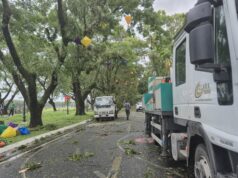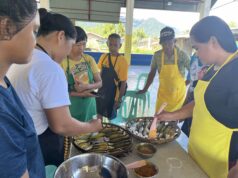Twenty-one-year old Jose Madera (not his real name) was only six days in his new job but he already felt something strange. He experienced stomach cramps.
“I went home and threw up,” he recalled. “Then, I fainted. When I woke up, I couldn’t move. I was completely immobile.”
After two months in hospital, Jose recovered partial use of his limbs, but still could not walk properly.
His job involved spraying a pesticide to bananas on a plantation. No one had given him protective gear nor warned him of the dangers on inhaling the chemical or absorbing it through his skin.
Jose was lucky; he survived. While there is little reliable data on the numbers poisoned by pesticides every year, 90 percent of the deaths are believed to occur in developing countries, according to a report released by the Panos Institute.
“Every year, hundreds of thousands of people are killed due to accidental poisoning by agricultural chemicals,” says Roy C. Alimoane, director of the Davao-based Mindanao Baptist Rural Life Center (MBRLC) Foundation, Inc.
This claim has been supported by a study done by the Department of Health. Pesticides, the study showed, account for the highest number of poisoning cases and deaths in the Philippines.
At the height of Masagana 99, which the late Ferdinand Marcos pushed as one of its programs, “pesticides killed 4,000 farmers in Central Luzon,” reports Nicanor Perlas III, an environmentalist who ran for president in the recent election.
Nothing has changed. Use of pesticides is still rampant. High pesticide applications are known in Lucban vegetable farms and in Pagsanjan rice fields. In Lucban, for instance, the levels of malathion use during 2007-2008 until mid-2009 were above the allowable WHO limits.
As a result of the widespread use of pesticides, all Filipinos are at risk of exposure to slow pesticide poisoning, reported Dr. Leonila M. Varca during the 10th Science Council of Asia Conference hosted by the National Research Council of the Philippines and the Department of Science and Technology.
The public, she claimed, is getting the residues from the pesticides used by farmers as shown, for example, in chicken and duck meat in Laguna, she said, citing studies showing high pesticides residue in the brain, heart and meat of these fowls.
“Pesticides are the major components of crop production in the Philippines, especially in rice and vegetable farming,” pointed out Dr. Varca who is with the College of Agriculture of the University of the Philippines at Los Baños.
The P6 billion industry includes insecticides (39 percent), fungicides (24 percent) and herbicides (23 percent). Most of these are used in rice farming (37 percent), plantation crops like banana and pineapple (28 percent), fruits (14 percent) and vegetables (12 percent).
The Rome-based Food and Agricultural Organization (FAO) of the United Nations estimates that up to 35 percent of the losses in annual crop production worldwide are due to pests – insects, weeds, plant diseases, rodents and birds. Of the estimated one million insects in the world, around 150 to 200 species frequently cause serious damage to crops.
When losses due to pests are combined with postharvest losses, worldwide food losses would amount to 45 percent “This is almost one half of the world’s potential food supply,” the FAO said in a statement.
The Fertilizer and Pesticide Authority defines pesticide as “any substance or mixture of substances intended for preventing, destroying, repelling, or mitigating any insects, rodents, nematodes, fungi or weeds, or any other form of life declared to be pest.” It also refers to “any substance or mixture of substances intended for use as a plant regulator, defoliant, or desiccant.”
Pesticides are either synthetic or botanical. The synthetic organic compounds, like malathion and paraquat, constitute the majority among the pesticides. They are synthesized from oil. Botanical or “natural pesticides” are extracted from vegetative parts. Well known examples are pyrethrum from pyrethrum flowers, rotenone from derris roots, nicotine from tobacco leaves, and azidiracthine from the neem tree.
For a long time, no one seemed to question on the safety of pesticides. Not until 1962, when marine biologist and writer Rachel Carson wrote the now classic Silent Spring. In her book, she described how pesticides cause long-term hazards to birds, fish, other wildlife, and humans, but provides only short-term gains to controlling the pests.
As a result of Carson’s book, them American President John F. Kennedy formed a science advisory committee to investigate her findings. They were soon confirmed and pesticides were banned from the United States six years later. Other countries followed suit.
However, the companies that profit from pesticides argue that these chemicals help solve the food shortages in developing countries. But that is not always the case, according to Barbara Dinham of the London-based Pesticide Trust.
In her book, The Pesticide Hazard, Dinham deplored that the biggest consumer of pesticides in developing countries is the sector that is growing food for export.
Pesticides, she claimed, are frequently pushed on countries and part of aid packages. “The Third World governments,” she wrote, “maintain that access to finance, and particularly aid funding, to buy agricultural chemicals is easier than for other products.”
In some instances, “donors stipulate that their funds be used to purchase pesticides from a specific origin. Others go further, and specify both the type of pesticide and the exporter.”
“The increasing awareness of the dangers posed by chemical pesticides to human health is prompting many Filipino farmers to use botanical formulations that they themselves are preparing,” said a paper written by L. Masana and A. Manuel.
“Natural pest controls like the botanicals are safer to the user and the environment because they break down into harmless compounds within hours or days in the presence of sunlight,” wrote Planet Natural’s Eric Vinje. “They are also very close chemically to those plants from which they are derived, so they are easily decomposed by a variety of microbes common in most soils.”
Many plants have insecticidal properties. Extracts of these plants can be sprayed on the crop to either kill or repel insects. Take the case of atis, which is best for use against aphids, ants and other crawling insects. The seed of the fruit is crushed and mixed with water. The solution is sprayed against target pests.
“I went home and threw up,” he recalled. “Then, I fainted. When I woke up, I couldn’t move. I was completely immobile.”
After two months in hospital, Jose recovered partial use of his limbs, but still could not walk properly.
His job involved spraying a pesticide to bananas on a plantation. No one had given him protective gear nor warned him of the dangers on inhaling the chemical or absorbing it through his skin.
Jose was lucky; he survived. While there is little reliable data on the numbers poisoned by pesticides every year, 90 percent of the deaths are believed to occur in developing countries, according to a report released by the Panos Institute.
“Every year, hundreds of thousands of people are killed due to accidental poisoning by agricultural chemicals,” says Roy C. Alimoane, director of the Davao-based Mindanao Baptist Rural Life Center (MBRLC) Foundation, Inc.
This claim has been supported by a study done by the Department of Health. Pesticides, the study showed, account for the highest number of poisoning cases and deaths in the Philippines.
At the height of Masagana 99, which the late Ferdinand Marcos pushed as one of its programs, “pesticides killed 4,000 farmers in Central Luzon,” reports Nicanor Perlas III, an environmentalist who ran for president in the recent election.
Nothing has changed. Use of pesticides is still rampant. High pesticide applications are known in Lucban vegetable farms and in Pagsanjan rice fields. In Lucban, for instance, the levels of malathion use during 2007-2008 until mid-2009 were above the allowable WHO limits.
As a result of the widespread use of pesticides, all Filipinos are at risk of exposure to slow pesticide poisoning, reported Dr. Leonila M. Varca during the 10th Science Council of Asia Conference hosted by the National Research Council of the Philippines and the Department of Science and Technology.
The public, she claimed, is getting the residues from the pesticides used by farmers as shown, for example, in chicken and duck meat in Laguna, she said, citing studies showing high pesticides residue in the brain, heart and meat of these fowls.
“Pesticides are the major components of crop production in the Philippines, especially in rice and vegetable farming,” pointed out Dr. Varca who is with the College of Agriculture of the University of the Philippines at Los Baños.
The P6 billion industry includes insecticides (39 percent), fungicides (24 percent) and herbicides (23 percent). Most of these are used in rice farming (37 percent), plantation crops like banana and pineapple (28 percent), fruits (14 percent) and vegetables (12 percent).
The Rome-based Food and Agricultural Organization (FAO) of the United Nations estimates that up to 35 percent of the losses in annual crop production worldwide are due to pests – insects, weeds, plant diseases, rodents and birds. Of the estimated one million insects in the world, around 150 to 200 species frequently cause serious damage to crops.
When losses due to pests are combined with postharvest losses, worldwide food losses would amount to 45 percent “This is almost one half of the world’s potential food supply,” the FAO said in a statement.
The Fertilizer and Pesticide Authority defines pesticide as “any substance or mixture of substances intended for preventing, destroying, repelling, or mitigating any insects, rodents, nematodes, fungi or weeds, or any other form of life declared to be pest.” It also refers to “any substance or mixture of substances intended for use as a plant regulator, defoliant, or desiccant.”
Pesticides are either synthetic or botanical. The synthetic organic compounds, like malathion and paraquat, constitute the majority among the pesticides. They are synthesized from oil. Botanical or “natural pesticides” are extracted from vegetative parts. Well known examples are pyrethrum from pyrethrum flowers, rotenone from derris roots, nicotine from tobacco leaves, and azidiracthine from the neem tree.
For a long time, no one seemed to question on the safety of pesticides. Not until 1962, when marine biologist and writer Rachel Carson wrote the now classic Silent Spring. In her book, she described how pesticides cause long-term hazards to birds, fish, other wildlife, and humans, but provides only short-term gains to controlling the pests.
As a result of Carson’s book, them American President John F. Kennedy formed a science advisory committee to investigate her findings. They were soon confirmed and pesticides were banned from the United States six years later. Other countries followed suit.
However, the companies that profit from pesticides argue that these chemicals help solve the food shortages in developing countries. But that is not always the case, according to Barbara Dinham of the London-based Pesticide Trust.
In her book, The Pesticide Hazard, Dinham deplored that the biggest consumer of pesticides in developing countries is the sector that is growing food for export.
Pesticides, she claimed, are frequently pushed on countries and part of aid packages. “The Third World governments,” she wrote, “maintain that access to finance, and particularly aid funding, to buy agricultural chemicals is easier than for other products.”
In some instances, “donors stipulate that their funds be used to purchase pesticides from a specific origin. Others go further, and specify both the type of pesticide and the exporter.”
“The increasing awareness of the dangers posed by chemical pesticides to human health is prompting many Filipino farmers to use botanical formulations that they themselves are preparing,” said a paper written by L. Masana and A. Manuel.
“Natural pest controls like the botanicals are safer to the user and the environment because they break down into harmless compounds within hours or days in the presence of sunlight,” wrote Planet Natural’s Eric Vinje. “They are also very close chemically to those plants from which they are derived, so they are easily decomposed by a variety of microbes common in most soils.”
Many plants have insecticidal properties. Extracts of these plants can be sprayed on the crop to either kill or repel insects. Take the case of atis, which is best for use against aphids, ants and other crawling insects. The seed of the fruit is crushed and mixed with water. The solution is sprayed against target pests.




